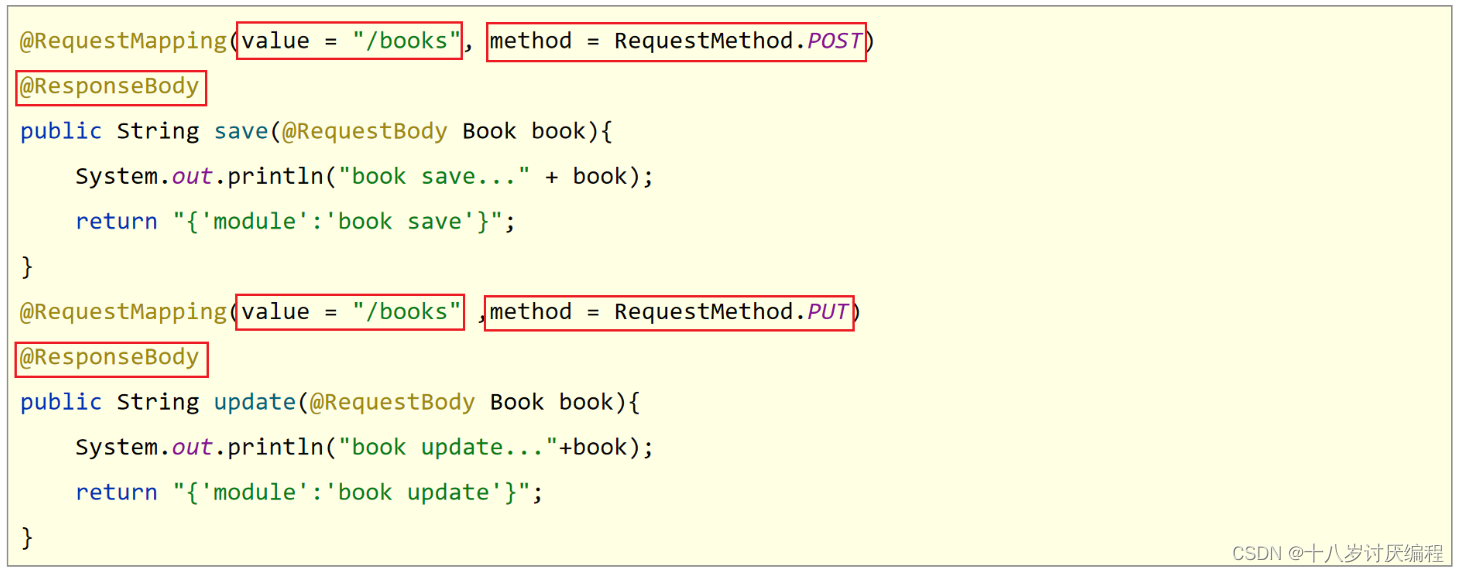REST 入门案例
案例需求与思路分析
需求:将之前的增删改查替换成 RESTful 的开发方式。
1.之前不同的请求有不同的路径,现在要将其修改为统一的请求路径
修改前: 新增: /save ,修改: /update,删除 /delete...
修改后: 增删改查: /users
2.根据 GET 查询、POST 新增、PUT 修改、DELETE 删除对方法的请求方式进行限定
3.发送请求的过程中如何设置请求参数?
环境准备
创建一个 Web 的 Maven 项目
pom.xml 添加 Spring 依赖
<?xml version="1.0" encoding="UTF-8"?> <project xmlns="http://maven.apache.org/POM/4.0.0" xmlns:xsi="http://www.w3.org/2001/XMLSchema-instance" xsi:schemaLocation="http://maven.apache.org/POM/4.0.0 http://maven.apache.org/xsd/maven-4.0.0.xsd"> <modelVersion>4.0.0</modelVersion> <groupId>com.nefu</groupId> <artifactId>springmvc_try</artifactId> <version>1.0-SNAPSHOT</version> <packaging>war</packaging> <dependencies> <dependency> <groupId>javax.servlet</groupId> <artifactId>javax.servlet-api</artifactId> <version>3.1.0</version> <scope>provided</scope> </dependency> <dependency> <groupId>org.springframework</groupId> <artifactId>spring-webmvc</artifactId> <version>5.2.10.RELEASE</version> </dependency> <dependency> <groupId>com.fasterxml.jackson.core</groupId> <artifactId>jackson-databind</artifactId> <version>2.9.0</version> </dependency> </dependencies> <build> <plugins> <plugin> <groupId>org.apache.tomcat.maven</groupId> <artifactId>tomcat7-maven-plugin</artifactId> <version>2.1</version> <configuration> <port>80</port> <path>/</path> </configuration> </plugin> </plugins> </build> </project>
复制代码
public class ServletContainersInitConfig extends AbstractAnnotationConfigDispatcherServletInitializer { protected Class<?>[] getRootConfigClasses() { return new Class[0]; } protected Class<?>[] getServletConfigClasses() { return new Class[]{SpringMvcConfig.class}; } protected String[] getServletMappings() { return new String[]{"/"}; } //乱码处理 @Override protected Filter[] getServletFilters() { CharacterEncodingFilter filter = new CharacterEncodingFilter(); filter.setEncoding("UTF-8"); return new Filter[]{filter}; } } @Configuration @ComponentScan("com.nefu.controller") //开启json数据类型自动转换 @EnableWebMvc public class SpringMvcConfig { }
复制代码
public class User { private String name; private int age; //getter...setter...toString省略 }
复制代码
@Controller public class UserController { @RequestMapping("/save") @ResponseBody public String save(@RequestBody User user) { System.out.println("user save..."+user); return "{'module':'user save'}"; } @RequestMapping("/delete") @ResponseBody public String delete(Integer id) { System.out.println("user delete..." + id); return "{'module':'user delete'}"; } @RequestMapping("/update") @ResponseBody public String update(@RequestBody User user) { System.out.println("user update..." + user); return "{'module':'user update'}"; } @RequestMapping("/getById") @ResponseBody public String getById(Integer id) { System.out.println("user getById..." + id); return "{'module':'user getById'}"; } @RequestMapping("/findAll") @ResponseBody public String getAll() { System.out.println("user getAll..."); return "{'module':'user getAll'}"; } }
复制代码
修改 REST 风格
现在我们将 UserController 进行改造:
新增
@Controllerpublic class UserController { //设置当前请求方法为POST,表示REST风格中的添加操作 @RequestMapping(value = "/users",method = RequestMethod.POST) @ResponseBody public String save() { System.out.println("user save..."); return "{'module':'user save'}"; }}
复制代码
将请求路径更改为/users
访问该方法使用 POST: http://localhost/users
使用 method 属性限定该方法的访问方式为POST
如果发送的不是 POST 请求,比如发送 GET 请求,则会报错
删除
@Controllerpublic class UserController { //设置当前请求方法为DELETE,表示REST风格中的删除操作 @RequestMapping(value = "/users",method = RequestMethod.DELETE) @ResponseBody public String delete(Integer id) { System.out.println("user delete..." + id); return "{'module':'user delete'}"; }}
复制代码
访问成功,但是删除方法没有携带所要删除数据的 id,所以针对 RESTful 的开发,如何携带数据参数?
传递路径参数
前端发送请求的时候使用:http://localhost/users/1,路径中的1就是我们想要传递的参数。
后端获取参数,需要做如下修改:
@Controllerpublic class UserController { //设置当前请求方法为DELETE,表示REST风格中的删除操作 @RequestMapping(value = "/users/{id}",method = RequestMethod.DELETE) @ResponseBody public String delete(@PathVariable Integer id) { System.out.println("user delete..." + id); return "{'module':'user delete'}"; }}
复制代码
思考如下两个问题:
(1)如果方法形参的名称和路径{}中的值不一致,该怎么办?
(2)如果有多个参数需要传递该如何编写?
前端发送请求的时候使用:http://localhost/users/1/tom,路径中的1和tom就是我们想要传递的两个参数。
后端获取参数,需要做如下修改:
@Controllerpublic class UserController { //设置当前请求方法为DELETE,表示REST风格中的删除操作 @RequestMapping(value = "/users/{id}/{name}",method = RequestMethod.DELETE) @ResponseBody public String delete(@PathVariable Integer id,@PathVariable String name) { System.out.println("user delete..." + id+","+name); return "{'module':'user delete'}"; }}
复制代码
修改
@Controllerpublic class UserController { //设置当前请求方法为PUT,表示REST风格中的修改操作 @RequestMapping(value = "/users",method = RequestMethod.PUT) @ResponseBody public String update(@RequestBody User user) { System.out.println("user update..." + user); return "{'module':'user update'}"; }}
复制代码
根据 ID 查询
@Controllerpublic class UserController { //设置当前请求方法为GET,表示REST风格中的查询操作 @RequestMapping(value = "/users/{id}" ,method = RequestMethod.GET) @ResponseBody public String getById(@PathVariable Integer id){ System.out.println("user getById..."+id); return "{'module':'user getById'}"; }}
复制代码
将请求路径更改为/users
查询所有
@Controllerpublic class UserController { //设置当前请求方法为GET,表示REST风格中的查询操作 @RequestMapping(value = "/users" ,method = RequestMethod.GET) @ResponseBody public String getAll() { System.out.println("user getAll..."); return "{'module':'user getAll'}"; }}
复制代码
将请求路径更改为/users
案例总结
RESTful 入门案例,我们需要学习的内容如下:
(1)设定 Http 请求动作(动词)
@RequestMapping(value="",==method== = RequestMethod.==POST|GET|PUT|DELETE==)
(2)设定请求参数(路径变量)
@RequestMapping(value="/users/=={id}==",method = RequestMethod.DELETE)
@ReponseBody
public String delete(==@PathVariable== Integer ==id==){
}
@PathVariable
关于接收参数,我们学过三个注解@RequestBody、@RequestParam、@PathVariable,这三个注解之间的区别和应用分别是什么?
区别
@RequestParam 用于接收 url 地址传参或表单传参
@RequestBody 用于接收 json 数据
@PathVariable 用于接收路径参数,使用{参数名称}描述路径参数
应用
后期开发中,发送请求参数超过 1 个时,以 json 格式为主,@RequestBody 应用较广
如果发送非 json 格式数据,选用 @RequestParam 接收请求参数
采用 RESTful 进行开发,当参数数量较少时,例如 1 个,可以采用 @PathVariable 接收请求路径变量,通常用于传递 id 值
RESTful 快速开发
做完了 RESTful 的开发,你会发现==好麻烦==,麻烦在哪?
问题 1:每个方法的 @RequestMapping 注解中都定义了访问路径/books,重复性太高。
问题 2:每个方法的 @RequestMapping 注解中都要使用 method 属性定义请求方式,重复性太高。
问题 3:每个方法响应 json 都需要加上 @ResponseBody 注解,重复性太高。
对于上面所提的这三个问题,具体该如何解决?
@RestController //@Controller + ReponseBody@RequestMapping("/books")public class BookController { //@RequestMapping(method = RequestMethod.POST) @PostMapping public String save(@RequestBody Book book){ System.out.println("book save..." + book); return "{'module':'book save'}"; }
//@RequestMapping(value = "/{id}",method = RequestMethod.DELETE) @DeleteMapping("/{id}") public String delete(@PathVariable Integer id){ System.out.println("book delete..." + id); return "{'module':'book delete'}"; }
//@RequestMapping(method = RequestMethod.PUT) @PutMapping public String update(@RequestBody Book book){ System.out.println("book update..." + book); return "{'module':'book update'}"; }
//@RequestMapping(value = "/{id}",method = RequestMethod.GET) @GetMapping("/{id}") public String getById(@PathVariable Integer id){ System.out.println("book getById..." + id); return "{'module':'book getById'}"; }
//@RequestMapping(method = RequestMethod.GET) @GetMapping public String getAll(){ System.out.println("book getAll..."); return "{'module':'book getAll'}"; } }
复制代码
对于刚才的问题,我们都有对应的解决方案:
问题 1:每个方法的 @RequestMapping 注解中都定义了访问路径/books,重复性太高。
将@RequestMapping提到类上面,用来定义所有方法共同的访问路径。
复制代码
问题 2:每个方法的 @RequestMapping 注解中都要使用 method 属性定义请求方式,重复性太高。
使用@GetMapping @PostMapping @PutMapping @DeleteMapping代替
复制代码
问题 3:每个方法响应 json 都需要加上 @ResponseBody 注解,重复性太高。
1.将ResponseBody提到类上面,让所有的方法都有@ResponseBody的功能2.使用@RestController注解替换@Controller与@ResponseBody注解,简化书写
复制代码
快速开发总结
知识点 1:@RestController
知识点 2:@GetMapping @PostMapping @PutMapping @DeleteMapping














![[SpringMVC]REST入门案例与优化_spring_fake smile by_InfoQ写作社区](https://static001.infoq.cn/static/infoq/img/logo-121-75.yuij86g.png)
评论